Duncan Aviation’s flight dept combines aviation expertise with operational reliability and efficiency
By David Bjellos
Contributing Writer
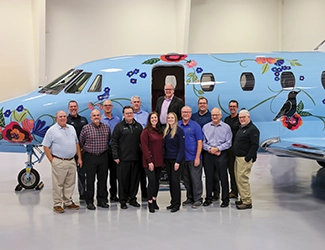
Business aviation is less than a century old, and only a handful of names have withstood the test of time to survive and remain viable.
The Duncan family name sits atop this very short list and they provide a wide variety of services, most notably the largest family-owned maintenance, repair, and overhaul (MRO) facilities in the world.
With primary facilities at LNK (Lincoln NE), BTL (Battle Creek MI), and PVU (Provo UT), and nearly 3000 team members worldwide, Duncan Aviation delivers premier aircraft services for nearly all makes and models of business aircraft.
Beginning in 1956, patriarch Donald Duncan established a family-run, closely-held private corporation dedicated to the sales and accompanying support of business aircraft.
They have been involved in sales (Learjet, Beechcraft, Piper), support services including FBO, fuel, avionics repair and installation, and – of particular note – the growing MRO business.
Leadership passed down over the years to son Robert, who handed the reins to the current chairman, Todd Duncan, in 2007. Unsurprisingly, this aviation family was quick to establish a flight department in its early years. Theirs is a unique and respected organization, serving the needs of the MRO, customers, and clients.
Chairman Todd Duncan
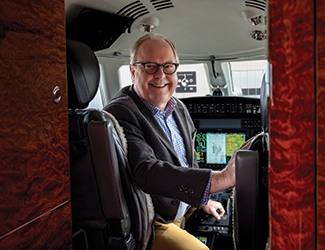
An active aviator since 1987, Todd still flies most of the inventory in the flight department. They also maintain a fleet of smaller piston aircraft, which Todd enthusiastically encourages all flight department team members to fly to improve their flying skills and add to their ratings.
These include an Aviat Husky on floats, a Piper Super Cub, 3 Beech Bonanzas, a Cessna 172 and a Pilatus PC-12. Todd loves interacting with team members, customers, and industry partners on a daily basis.
He is active in industry affairs and was chair of NBAA’s Associate Member Advisory Committee in 2022.
He maintains a very close relationship with all flight department personnel and is active in the safety management system and departmental policies.
He also encourages his sons, PK and Harrison, to be active in the business and in the flight department.
CFO Jamie Harder
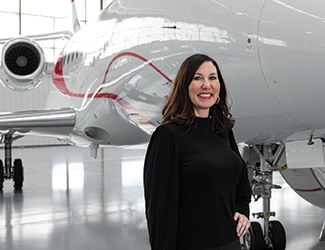
Jamie Harder is executive vice president and CFO of Duncan Aviation, and is the senior leader responsible for Duncan Aviation’s flight department.
Harder has always had a passion for aviation and attends regular safety and general staff meetings to better understand the challenges faced by the group. She especially enjoys the benefits of working for a family-oriented company.
Her responsibilities include accounting, credit, information services, purchasing, and facilities.
Harder also takes pride in her work with the Duncan Family Trust – the philanthropic arm of Duncan Aviation which manages grants and charitable contributions that enhance education, create positive change in the communities where Duncan Aviation is located, and increase awareness and interest in aviation.
Director of Maintenance Alan Weigle
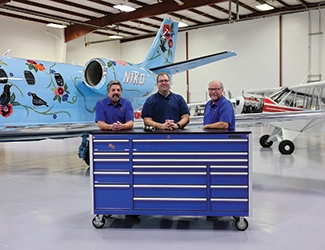
Alan Weigle is a longtime employee of Duncan Aviation who started his career with the company as an avionics line technician and then returned as service inspector for the MRO side of the business.
He began working in the flight department 2 years ago to bridge the gap for semi-retiring Director Andy Bajc, who has been with the company for 44 years.
Weigle has a wide range of technical expertise and specializes in avionics. He is an active airman, and enjoys flying his own home-built experimental aircraft and Piper Comanche.
Weigle uses a proprietary software created by Duncan Aviation called Tracker to keep track of the inspection and interval maintenance requirements for the varied fleet, which consists of a Cessna Citation M2, a Citation XLS, a PC-12, and 3 Bonanzas. In total, the corporate flight division is responsible for 15 aircraft (including the Super Cub and float-equipped Husky).
Weigle stresses how important the maintenance function is within the organization, and refers to the fact that they have a wealth of knowledge within the ranks of MRO technicians when they encounter a problem. “We don’t live on an island, and are grateful to the depth of expertise we have from within the MRO ranks” was his response to how they handle difficult mechanical issues.
Director of Flight Operations Craig Rathjen

Craig Rathjen has been with the Duncan Aviation flight department since 1997 and oversees 17 pilots (3 part-time), 3 maintenance technicians, and 1 scheduler. Rathjen reports that the department is almost exclusively Part 91, but they do maintain a small group of aircraft on a Part 135 certificate to help facilitate new customer transition from charter to ownership.
This simplifies the accounting and regulatory processes required and benefits the customers who need the interim flexibility.
According to Rathjen, new-hire pilots can be placed into captain positions, and this requires 3000 hours and turbine experience. New first officers are competitive with 1200 hours and a strong willingness to learn and be part of the team.
The PC-12 has occasionally been used to hire a PIC without pure turbojet time, but this is the exception.
The pilot staff has a very healthy mix of tenured airmen as well as newer, younger staff who will matriculate over time. Quality of life and support in the workplace are paramount, and this is driven from the top by the chairman.
Duncan Aviation pilots train at FlightSafety Intl and alternate types every other training event. Nearly all pilots are trained on 2 airframes. In 2010, Rathjen, who was chief pilot at the time, was heavily involved in incorporating a formal safety management system (SMS).
Duncan Aviation’s flight department successfully completed its first International Standard for Business Aviation Operations (IS-BAO) audit in 2011 – it is currently Stage III. The department has a dedicated safety officer, who oversees the IS-BAO protocols and distribution of data to the pilot group.
 Uniquely designed and painted “flying billboards” for Duncan Aviation MRO paint capabilities, the corporate fleet shows off the expertise of the company’s designers and paint technicians.
Uniquely designed and painted “flying billboards” for Duncan Aviation MRO paint capabilities, the corporate fleet shows off the expertise of the company’s designers and paint technicians.
Captain & Safety Officer Paul Higgins
Captain Paul Higgins is the department’s safety officer. His motto, and that of the entire department, is “Always improving.” Higgins joined the department in 2018 and has 11,500 flight hours in Citations, the Falcon 50, and the Cessna 560XL.

He produces a quarterly summary of flights, reportable events, and anomaly reports. Company policy is that every flight will have a completed flight risk assessment tool (FRAT). The Smartsheet app is used for compliance – once completed, they are submitted electronically.
Encouraged by Flight Ops Dir Rathjen, Higgins has attended the Bombardier Safety Standdown and NBAA/BACE annually.
Because Chairman Todd Duncan encourages his employees to fly all the aircraft available to them (including non-aviation department personnel), Higgins reports that applying the SMS to regular employees is not as challenging as one might expect.
Because there is so much enthusiasm for aviation, the pilots adapt quickly to the SMS concept, and Higgins reports the risk profiles for multiple pilots as very manageable.
Higgins administers the IS-BAO program and maintains the protocols and reporting requirements for the standard. One minor challenge is the (current) lack of flight operations quality assurance (C-FOQA) digital data for the smaller aircraft.
While common on larger Part 25 turbojets, affordable units for the fleet types operated by Duncan Aviation remain very limited, although Higgins reports that this is changing. He is looking forward to the adoption of more affordable and accessible digital reporting by companies like Garmin, ForeFlight and Rockwell Collins to enhance their reporting through increased aggregate data.
The Duncan Aviation MRO facilities employ highly-skilled technicians who have trained on nearly all makes of new and in-service business jets. They have authorizations from many foreign regulators to perform maintenance and return-to-service functions.
Administrative Coordinator Stacy Hilton
Always the heart and soul of any flight department is the interface between the requester and the flight department. Stacy Hilton has been with Duncan Aviation’s flight department for nearly 21 years and enjoys her position immensely, with its daily challenges of juggling passengers, pilots, and aircraft, as well as the camaraderie of the group in general.
She uses BART software and communicates to the group via all the usual lines – text, voice, e-mail. Hilton has attended the NBAA Schedulers and Dispatchers Conference for many years and has learned a great deal from the event that has benefitted her position directly.
(L) With a striking paint scheme designed to reflect a fishing motif, the Pilatus PC-12 is an eye-catcher on any ramp. (R) Duncan Aviation’s satellite facility at APA (Centennial, Denver CO) outfitted the PC-12’s flight deck with all-new Garmin systems.
Hilton applies a company directive which provides all flight department staff with a rotation of 3 weeks on, then 6 days off (Tuesday through Sunday). Since the department is properly staffed, this mandate is rarely broken. The pilot and maintenance group helped develop this schedule – their participation ensured proper buy-in and the results are positive.
Summary
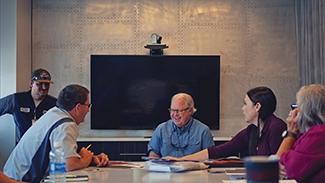
Living in the Midwest has certain benefits – 4 distinct seasons, a somewhat relaxed pace of life, affordable housing, and abundant land for recreation, hunting, fishing, and outdoor activities.
The Duncan Aviation flight department has many 35-year-plus employees, and the promise of a stable lifestyle with good time off and quality of life balance makes Lincoln a desirable location.
Expansion of MRO facilities to PVU in recent years has expanded the company’s footprint, and the flight department has grown and adapted to maintain personal contact for Duncan Aviation team members and customers.
The next generation of the Duncan family are learning the business and have developed a solid footing from which to expand, innovate, and thrive in this very competitive business.
The next 70 years promise to be as dramatic as the previous.
 Senior contributor David Bjellos has been writing for PP since 2004. He is an active airman flying a G650 based in south Florida.
Senior contributor David Bjellos has been writing for PP since 2004. He is an active airman flying a G650 based in south Florida.

